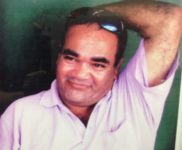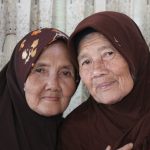Suspicious Circumstances: Mark Mason Was Outnumbered When Fatally Shot

Gomeroi man Mark Mason was shot twice by a police officer, who was one of five surrounding and attempting to arrest him in a bedroom of a house located in the small north western NSW town of Collarenebri on 11 November 2010.
According to Mr Mason’s family, there was no justification for NSW police senior constable Michael Bobako to have discharged his gun, as the 44-year-old former Aboriginal Legal Service NSW/ACT field officer was outnumbered by attending police, who could have easily subdued him.
The five police officers were seeking to arrest the father-of-four over an alleged domestic dispute. And officers had been pursuing him after he’d reportedly crashed a vehicle he was driving into a police car.
But, by the time officer Bobako shot Mr Mason twice at close range, officers had used capsicum spray upon him, as well as tasered him two times, one of which was a drive stun, meaning they were close enough to have placed the device directly on the First Nations man’s body.
And while it’s true that during the last 40 seconds of his life, Mason picked up a tyre lever and swung it in the direction of an officer, there were still four others present that could have overpowered him. However, the NSW deputy coroner found this Aboriginal death in custody was justified.
Shot twice at close proximity
“There were four men standing at the door, who could quite easily have subdued Mark,” said Marcia Mason-Hoskins, the Gomeroi man’s sister. “He was face on to the cop who was in the corner. So, he was sideways or either had his back to the ones standing at the door.”
“I have no idea why they would need to shoot,” she told Sydney Criminal Lawyers, “because there were other ways to stop it from happening.”
Claims that the senior constable who shot Mr Mason was acting in self-defence are false, as far as Ms Mason-Hopkins is concerned. And she cites a number of different occasions when the attending officers could have restrained her brother.
According to accounts, at one point Mark landed on his knees after being tasered, whilst following the other tasering he’d landed on the bed. And his sister claims one of the officers kicked Mr Mason, which reveals they were quite close to him.
“The eventual shooter was that close to Mark that he drive stunned him with a taser, which means he put the taser onto Mark’s skin,” Mason-Hoskins further recalled. “There were opportunities to grab him, because there were five of them. So, that opportunity was overlooked.”
Enhanced surveillance
Mr Mason was on the Suspect Targeting Management Plan (STMP), which is a secretive blacklist that the NSW Police Force has been running since 2000. Those placed on the list receive increased surveillance, which includes being stopped and searched, as well as having police visit their homes.
“It meant that he had the police sitting across from his home three times a week for half hour intervals,” Ms Mason-Hoskins explained. “It meant that his car was searched. And he was searched. If he had passengers in the car, they too were searched.”
STMP targets are placed on the list because police believe they’re at risk of committing crimes in the future. And this preventative policing measure involves targeting not only those who have been convicted of past crimes, but even some individuals who don’t have a criminal record.
Mr Mason had been placed on the list due to suspicions he used illicit substances. However, at no point on the numerous occasions that police stopped and searched the Gomeroi man, did an officer find him in possession of illegal drugs.
“He had no privacy, even though they’d never found anything on him,” his sister emphasised. “And even with the toxicology report, nothing was in his system, no drugs or alcohol. He didn’t use drugs, and he didn’t drink.”
A 2017 report found that the STMP disproportionately targets Aboriginal people. Data from five local area commands over a two year period found 54 percent of targets were First Nations people, despite Indigenous people only accounting for only 3.4 percent of the overall NSW population.
“No recommendations whatsoever”
The Mason family had to wait for three years for the coronial inquest into the death of their loved one. Then NSW deputy coroner Hugh Dillon pronounced that the officers at the scene had acted “correctly and justifiably”, while he asserted constable Bobako had acted in self-defence.
The family were none too happy about how the proceedings progressed, which led to family members storming out of the courtroom on the final day of the inquest. And the coroner made no recommendations in his final report.
The coroner’s findings dated 4 October 2013 say very little about the case itself. Rather, the report outlines that a request was made by the family to the NSW police commissioner asking for access to “documents relating to allegations of use of excessive force by police officers”.
Then the coronial report provides three pages of detailed reasoning relating to why the family was not permitted to access the documents that included the notebooks of officers at the scene, police computer database entries, and documents regarding internal investigations into the matter.
End black deaths in custody
Mark Mason’s cousin TJ Hickey was another First Nations individual who died in custody. The 17-year-old Gamilaraay boy died whilst he was being pursued by a police van as he was riding a bike in Sydney’s Redfern in 2004.
The two men are amongst a list of over 420 First Nations people who have died whilst in the custody of either police or corrective services since the findings of the Royal Commission into Aboriginal Deaths in Custody were handed down in 1991.
The FIRE and Indigenous Social Justice Association led Blak Deaths in Custody campaign is currently drawing attention to a number of Indigenous deaths inside over the last decade in a bid to bring about much needed reforms to end these deaths at the hands of the settler colonial state.
“It’s outrageous,” remarked Ms Mason-Hoskins, when asked about the ever-rising number of First Nations people dying while detained. “As far as I’m concerned, one death in custody is one too many.”







